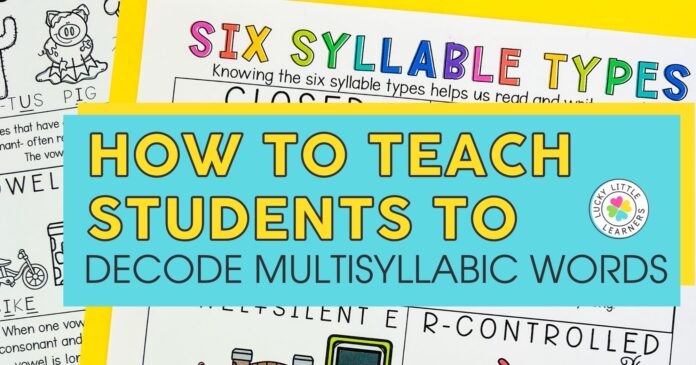
How to Teach Multisyllabic Words: Strategies for Success
Introduction
Teaching multisyllabic words to students can be a challenging task, especially for those who struggle with reading and language skills. However, with effective strategies and techniques, educators can make the process more engaging and accessible for their students. In this article, we will explore some proven methods to teach multisyllabic words, empowering teachers to facilitate their students’ growth and development in language acquisition.
1. Start with Phonological Awareness
Phonological awareness is the foundation for reading and spelling skills. Before diving into multisyllabic words, it is crucial to ensure that students possess a strong understanding of sound-letter correspondence and syllable segmentation. Engage students in activities such as clapping out syllables in words, blending sounds to form words, and manipulating sounds to create new words. By strengthening their phonological awareness skills, students will be better equipped to tackle more complex words.
2. Break Down Words into Syllables
When encountering multisyllabic words, students often get overwhelmed by their length and complexity. Breaking down these words into smaller syllables can make them more manageable and easier to decode. Teach students to identify and segment syllables in words using various techniques like clapping, tapping, or using their fingers. Visual aids such as syllable cards or color-coded markers can also help students visualize and separate each syllable.
3. Teach Syllable Types and Patterns
Introducing students to different syllable types and patterns can assist them in decoding multisyllabic words effectively. Teach them about closed syllables, open syllables, silent e syllables, vowel-consonant-e syllables, and vowel teams. Explain the rules associated with each syllable type, emphasizing the patterns that govern vowel sounds and syllable division. Encourage students to identify these patterns in words and use them as clues for pronunciation and spelling.
4. Provide Word Chunks and Affixes
Dividing multisyllabic words into smaller word chunks or affixes can help students identify familiar word parts and make connections to their existing vocabulary. For example, the word “happiness” can be divided into “happy” and “ness.” Introduce students to common prefixes (e.g., un-, re-, dis-) and suffixes (-ly, -able, -tion), explaining their meanings and how they alter the base word. By recognizing familiar word parts, students can decipher the meaning and pronunciation of unfamiliar multisyllabic words.
5. Incorporate Multisensory Techniques
Engaging students in multisensory activities can enhance their understanding and retention of multisyllabic words. Involve visual, auditory, and kinesthetic elements to cater to different learning styles. For visual learners, use charts, word walls, or flashcards to display and review multisyllabic words. Auditory learners can benefit from listening to word pronunciations and practicing verbal repetition. Kinesthetic learners can engage in tactile activities such as building words with manipulative letter tiles or writing words in the air.
6. Contextualize Words in Meaningful Sentences
Help students understand and apply multisyllabic words by placing them in context. Provide sentences or short passages where the words are used correctly, allowing students to grasp their meaning and usage. Encourage students to create their own sentences using the words, reinforcing their understanding and promoting vocabulary expansion.
7. Practice Regularly
Consistent practice is crucial for students to internalize their learning and confidently tackle multisyllabic words. Incorporate regular word study sessions into your curriculum, providing opportunities for students to practice decoding and spelling multisyllabic words. Interactive games, puzzles, and word-building activities can make practice more enjoyable and engaging. Consider using online resources and apps that offer interactive, multisyllabic word exercises.
8. Provide Feedback and Reinforcement
Offer ongoing feedback to students, highlighting their progress and pointing out areas for improvement. Celebrate their successes, no matter how small, to boost their confidence and motivation. Reinforce their learning by regularly revisiting previously taught multisyllabic words, challenging them to apply their knowledge independently.
Conclusion
Teaching multisyllabic words requires patience, creativity, and effective strategies. By focusing on phonological awareness, breaking down words into syllables, teaching syllable types and patterns, providing word chunks and affixes, incorporating multisensory techniques, contextualizing words, regular practice, and providing feedback and reinforcement, educators can equip their students with the necessary skills to confidently navigate and master multisyllabic words. With persistence and support, students will be on their way to becoming proficient readers and articulate speakers.


















